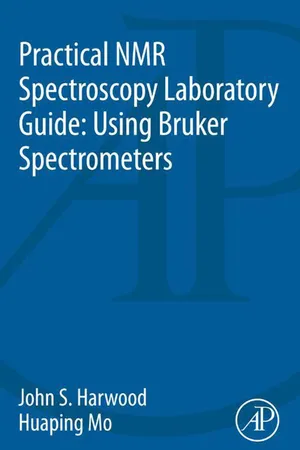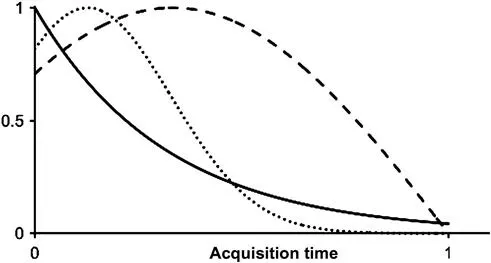
Practical NMR Spectroscopy Laboratory Guide: Using Bruker Spectrometers
- 136 pages
- English
- ePUB (mobile friendly)
- Available on iOS & Android
Practical NMR Spectroscopy Laboratory Guide: Using Bruker Spectrometers
About this book
Practical NMR Spectroscopy Laboratory Guide is designed to provide non-expert NMR users, typically graduate students in chemistry, an introduction to various facets of practical solution-state NMR spectroscopy. Each chapter offers a series of hands-on exercises, introducing various NMR concepts and experiments and guiding the reader in running these experiments using an NMR spectrometer. The book is written for use with a Bruker NMR spectrometer running TopSpin software versions 1 or 2. This practical resource functions both as a text for instructors of a practical NMR course and also as a reference for spectrometer administrators or NMR facility directors when doing user training. This guide serves as serve as excellent, practical resource on its own or as a companion book to Timothy Claridge's High-Resolution NMR Techniques in Organic Chemistry, 2nd Edition (Elsevier, 2009).- Written by experts in solution-state NMR spectroscopy- Provides step-by-step instructions for more than 50 activities using a Bruker NMR spectrometer- Includes detailed appendices and sample questions for lab reports
Frequently asked questions
- Essential is ideal for learners and professionals who enjoy exploring a wide range of subjects. Access the Essential Library with 800,000+ trusted titles and best-sellers across business, personal growth, and the humanities. Includes unlimited reading time and Standard Read Aloud voice.
- Complete: Perfect for advanced learners and researchers needing full, unrestricted access. Unlock 1.4M+ books across hundreds of subjects, including academic and specialized titles. The Complete Plan also includes advanced features like Premium Read Aloud and Research Assistant.
Please note we cannot support devices running on iOS 13 and Android 7 or earlier. Learn more about using the app.
Information
Basics and Spectrometer Performance Checks
Abstract
Keywords
Overview
Sample and Spectrometer Requirements
Activities

Part 1—Familiarization
| gb | 0.3 (range is 0–1) |
| lb | −0.5 (approximate value is ca. −(1/AQ)) |
| ssb | 1 or 2 (1 for sine-bell, 2 for cosine) |
To apply the window function to the raw NMR data (the Free Induction Decay or FID), click the OK button in the popup window. Then to generate the new spectrum use either the ft or fp command (fp applies the previously-determined phase correction, using processing parameters PHC0 and PHC1, to the spectrum, whereas ft generates a spectrum without phase correction). Feel free to experiment with other window functions—the original FID remains unchanged, only the spectrum changes.

Part 2—Shimming and Lineshape
Table of contents
- Cover image
- Title page
- Table of Contents
- Copyright
- Acknowledgments
- Introduction
- Chapter 1. Basics and Spectrometer Performance Checks
- Chapter 2. Multiple Irradiation and Multiple Pulse Experiments
- Chapter 3. Polarization Transfer and Its Applications
- Chapter 4. Homonuclear Correlation Experiments
- Chapter 5. PFG (Pulsed Field Gradient) Experiments
- Chapter 6. Introduction to NMR of Biomolecules in H2O
- Chapter 7. Selective Experiments Using Shaped Pulses
- Chapter 8. Diffusion Measurements and DOSY (Diffusion Ordered SpectroscopY)